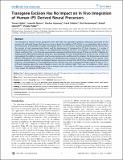Transgene Excision Has No Impact on In Vivo Integration of Human iPS Derived Neural Precursors
Author(s)
Major, Tamara; Menon, Jayanthi; Auyeung, Gordon; Soldner, Frank; Hockemeyer, Dirk; Jaenisch, Rudolf; Tabar, Viviane; ... Show more Show less
DownloadMajor-2011-Transgene Excision H.pdf (5.811Mb)
PUBLISHER_CC
Publisher with Creative Commons License
Creative Commons Attribution
Terms of use
Metadata
Show full item recordAbstract
The derivation of induced human pluripotent stem cells (hiPS) has generated significant enthusiasm particularly for the prospects of cell-based therapy. But there are concerns about the suitability of iPS cells for in vivo applications due in part to the introduction of potentially oncogenic transcription factors via viral vectors. Recently developed lentiviral vectors allow the excision of viral reprogramming factors and the development of transgene-free iPS lines. However it is unclear if reprogramming strategy has an impact on the differentiation potential and the in vivo behavior of hiPS progeny. Here we subject viral factor-free, c-myc-free and conventionally reprogrammed four-factor human iPS lines to a further challenge, by analyzing their differentiation potential along the 3 neural lineages and over extended periods of time in vitro, as well as by interrogating their ability to respond to local environmental cues by grafting into the striatum. We demonstrate similar and efficient differentiation into neurons, astrocytes and oligodendrocytes among all hiPS and human ES line controls. Upon intracranial grafting in the normal rat (Sprague Dawley), precursors derived from all hiPS lines exhibited good survival and response to environmental cues by integrating into the subventricular zone, acquiring phenotypes typical of type A, B or C cells and migrating along the rostral migratory stream into the olfactory bulb. There was no teratoma or other tumor formation 12 weeks after grafting in any of the 26 animals used in the study. Thus neither factor excision nor persistence of c-myc impact the behavior of hiPS lines in vivo.
Date issued
2011-09Department
Massachusetts Institute of Technology. Department of Biology; Whitehead Institute for Biomedical ResearchJournal
PLoS ONE
Publisher
Public Library of Science
Citation
Major, Tamara et al. “Transgene Excision Has No Impact on In Vivo Integration of Human iPS Derived Neural Precursors.” Ed. Debra L. Silver. PLoS ONE 6.9 (2011): e24687. Web. 10 Feb. 2012.
Version: Final published version
ISSN
1932-6203